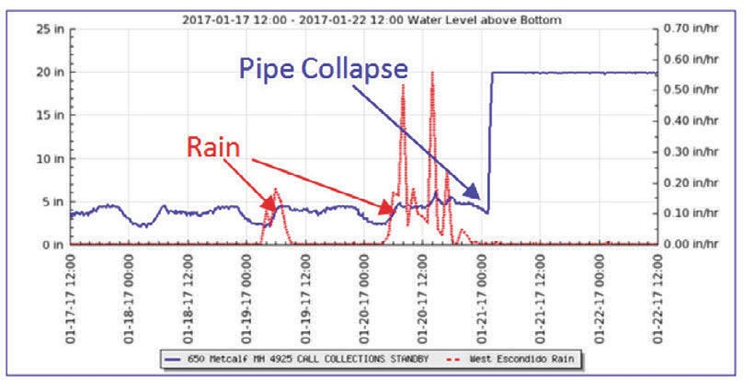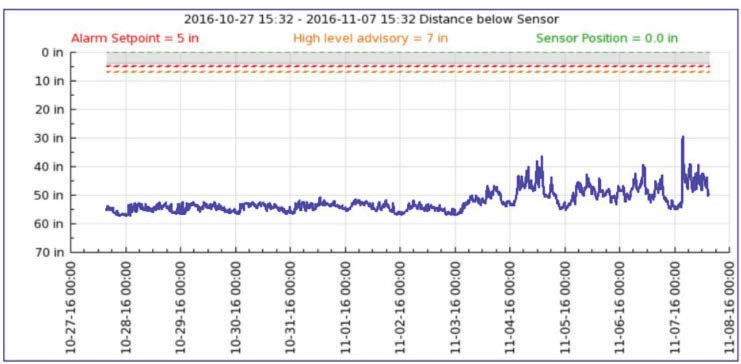The Future Of Collection Systems
By Ron Toten
As real-time monitoring continues to infiltrate the water industry, it’s time to apply such instrumentation to detect the other type of infiltration — along with inflow, snow and ice melt, etc.
Even in an industry that is historically slow to adopt innovation, collection systems may represent the least technologically advanced systems in the entire utility estate. Typically driven by gravity and wholly out of sight, our critical collection systems become noticeable only when they back up, produce overflows, or emit odors — events that can be difficult to detect, mitigate, predict, and prevent.
The unmonitored condition of collection systems belies the absolute importance of this infrastructure in protecting public health, the environment, and our standard of living. And in the future, our collection systems will take on an even greater role: protecting the sustainability of our water resources, managing extreme weather events, and ensuring that contaminants are secured and properly treated. This demands that we look critically at our collection systems and invest the necessary resources to ensure they are up to the task.
The collection system of the future will be rooted in an understanding of real-time conditions and digital data designed to:
- Maximize the operational availability of our constructed infrastructure;
- Adapt to rapidly and dynamically changing volume, velocity, and constituents;
- Maximize the effectiveness and reduce costs of operations;
- Protect water reclamation assets; and
- Ensure the integrity of recoverable resources.
Operational Availability
Operational availability can be defined as the ability for a system to operate as designed when required. For collection systems, this means being ready in all respects to convey wastewater and stormwater under a wide spectrum of operating conditions, including:
- Significant and rapid changes in flow conditions from storm events, inflow, and infiltration; and
- The long-term impacts of external factors such as solids deposition and the effect of fats, roots, oils, and greases (FROGs).

Figure 1. Real-time event detection
This operational availability must be delivered with minimum cost and maximum utility of existing assets. Squeezing every drop of capacity out of our collection systems requires that we understand the dynamic conditions under which they operate. As a function of the generally hazardous nature of the operating environment in enclosed sewers, the real-time data collection, transmission, and monitoring is extremely challenging. However, innovation in intrinsically safe and robust sensors is making real-time diagnostics and event detection a reality for utilities, allowing the implementation of proactive measures to improve response.
Adapting To Changing Conditions
One of the consequences of an increased drive for water conservation has been an overall reduction in wastewater hydraulic flow. Water conservation standards reducing toilet water use from 6 to 1.5 gallons per flush have resulted in significant water savings. For wastewater, reducing flow but transporting the same mass has translated into two operational issues: increased total suspended solids (TSS) and biochemical oxygen demand (BOD) loadings in sewers and wastewater treatment plants; and decreased scouring flows in sewers.
From a design perspective, typical rules of thumb still postulate a flow of 250 GPD per home with TSS and BOD values of 250 mg/L each. Today, it is typical for homes to generate in the order of 140 GPD, driving an increase of constituent loading (BOD/TSS) to 350 to 500 mg/L. This effective doubling of solids and biological loadings in our sewers, combined with the reduced hydraulic flow, results in solids deposition and creates the potential for anaerobic solids decomposition and the generation of hydrogen sulfide (H2S) gas.
Managing H2S generation, which is converted to sulfuric acid, is often addressed by a combination of flushing, pH control, and chemical dosing. However, using sensors and data to prevent the potential for H2S-generating conditions in the first place is a much more cost-effective solution and can prevent the corrosion and general deterioration of sewers. As a result, detecting and responding to anaerobic conditions prior to the onset of structural impacts significantly increases the longevity of our collection systems pipelines and reduces the total cost of operations (TOTEX).
Similarly, knowing how, when, and where to deploy cleaning activities can result in substantial savings for the utility. Rather than using a time-based, geographically homogenous model for determining cleaning activities, utilities can monitor levels in their systems to locate the hot spots where surging or low-flow conditions are contributing to the accumulation of solids, allowing for the strategic targeting of cleaning assets. Using data-driven analytics and strategically deployed real-time sensors, utilities like San Antonio Water System have reduced cleaning operations by 94 percent, while virtually eliminating overflows for those monitored assets.
Maximizing Efficiency
Many utilities manage their collection systems through capacity assurance, management, operations, and maintenance (CMOM) programs to prevent sanitary sewer overflows and maintain the design capacity of their collection systems. While these programs are effective planning-and-management tools, they are often not designed to respond to rapidly evolving events. With data and pattern recognition platforms, the operators of the collection system of the future will be able to identify the incipient conditions that can result in a system failure — grit buildup, FROG impacts, upstream and downstream blockages, hydraulic surges, etc. — before they result in threats to public health.
With the availability of real-time data and decision support tools, collection systems can be maintained at their optimum, and personnel and material resources can be most effectively deployed.
Protecting Our Wastewater Treatment And Reclamation Assets
Hydraulic and biological loading rates are critical elements of wastewater treatment, and managing high flows and rapidly fluctuating constituent levels protects our treatment facilities from:
- Biomass washout from peak flows, and
- Biomass mortality from high biological loading or toxic influent.

Figure 2. Incipient failure detection
Both of these conditions can take weeks to recover, result in significant financial impacts, and expose the utility to fines and other penalties. Avoiding these requires that utilities actively manage the hydraulic and constituent integrity of the collection system.
Hydraulic Integrity
Our collection systems can be subject to both inflow and infiltration from external events, but the cause and response differ significantly. Inflow represents the inundation of collection systems with stormwater, which can be the result of localized or large-scale flooding from storm events and snow and ice melt, and usually manifests as rapid increases in flow rates. Infiltration, on the other hand, is typically the result of either an increase of local groundwater levels or saturation of the soil column that drives water into the collection system through defects in pipe joints, manhole rings, or manhole covers.
Identifying whether your utility is experiencing infiltration or inflow — and the magnitude of each — is a key driver in keeping nonsanitary wastewater from the collection systems. With real-time monitoring, this differentiation is possible and the correct action can be implemented.
By integrating data from local precipitation and watercourse and tidal conditions, operators can anticipate problems and deploy resources in advance to ensure the integrity of the collection system to protect the treatment system.
Quality Integrity
As the drive for reuse increases, protection of the quality recycled water is imperative. This is particularly important for direct potable reuse (DPR) applications or where recycled water is used in areas of probable human contact. Ensuring that the constituents of the wastewater are controlled and capable of being effectively treated by the water reclamation facilities is crucial to the success of these water resource conservation schemes. This means moving the prevention, detection, and diversion of constituents that may have a deleterious impact on the quality of reclaimed water upstream, into the collection systems.
As part of the collection system of the future, utilities will need more closely coupled collection-system-monitoring programs and pretreatment programs to ensure that non-biodegradable, toxic, radioactive, and other contaminants are not released to wreak havoc on the quality of recycled water and therefore limit its future use. Real-time monitoring and control of collection system discharges will be critical to this endeavor.
Creating And Protecting A Resource Pipeline
Wastewater is a source of heat, trace minerals and metals, and other raw or reusable resources. Understanding where the best recovery points are, where to extract waste heat, and how to ensure that these extraction practices do not result in downstream problems with constituent precipitation, deposition, or obstruction is a vital component of the collection system of the future. In addition, as we move to resource recovery, the watertight integrity of our collection systems is very important. Allowing infiltration or inflow to dilute these recoverable resources will significantly disrupt the removal efficiency of any recovery system.
The Future: Integrated Real-Time Data Management, Collection, And Analysis
The future of our collection systems lies at the convergence of sensors, communications, and analytics.
Data-driven decision-support tools help utility staff visualize real-time conditions and allow the implementation of proactive measures to keep ahead of any potential issues. Investing in collection systems integrity provides opportunities to maximize the operational availability of our built infrastructure and allows for cost-effective resource recovery while maximizing the efficiency of operations. Attaining each of these goals is key to the financial and operational sustainability of our utilities.
The development and deployment of self-contained, intrinsically safe sensors capable of communicating efficiently across long distances at low cost and low bandwidth with highly reliable communications is driving this vision of the future. Along with event detection and analytics platforms that combine disparate data sets to enhance the real-time understanding of the dynamic conditions in our collection systems, our utilities have the opportunity to take a giant leap forward in managing these critical assets.
About The Author
 Ron Toten, senior project manager at SmartCover, is an experienced leader in operations and technology management, acknowledged for combining business acumen and technology to develop and execute strategic business plans to improve the bottom line. Ron supervises SmartCover installations across North America, ensuring the highest standards are met and the results are optimized — whether the solution is targeting blockages, high-frequency cleaning, inflow and infiltration, or H2S. Ron earned his BS in chemistry from University of California, Davis. He is based out of Orange County, CA, and can be reached at rtoten@smartcoversystems.com.
Ron Toten, senior project manager at SmartCover, is an experienced leader in operations and technology management, acknowledged for combining business acumen and technology to develop and execute strategic business plans to improve the bottom line. Ron supervises SmartCover installations across North America, ensuring the highest standards are met and the results are optimized — whether the solution is targeting blockages, high-frequency cleaning, inflow and infiltration, or H2S. Ron earned his BS in chemistry from University of California, Davis. He is based out of Orange County, CA, and can be reached at rtoten@smartcoversystems.com.
